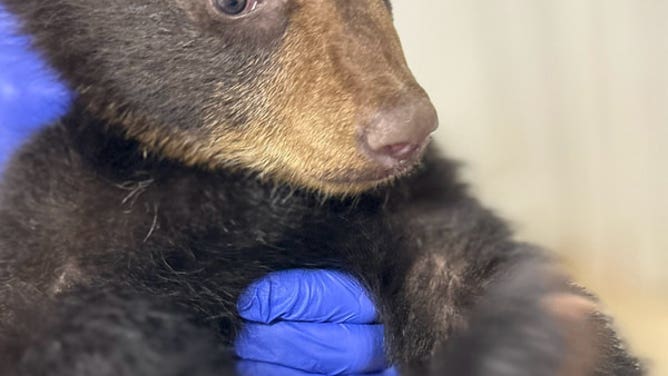Someone caught people behaving badly from her apartment. The video shows a group of people pulling a bear cub out of a tree for a selfie.
CHANDLER, N.C. – A wildlife refuge has happy news to report two weeks after a disturbing video of a group of people pulling bear cubs out of a tree to take selfies went viral.
The Appalachian Wildlife Refuge has been taking care of the orphaned cub and said she is now stabilized. Responding to a police call, the North Carolina Resources Wildlife Commission found one cub after her two siblings escaped the photo shoot, presumably to rejoin mom.
The commission placed her with the Appalachian Wildlife Rescue, one of the two rescues in the state in the Black Bear Cub Rehab Program.
“Following a time to adjust to being in our care, she was introduced to another orphaned cub that arrived previously. Both cubs are thriving and doing well in care,” Appalachian Wildlife Refuge Executive Director Savannah Trantham said in a statement. “They are eating well and interacting with enrichment, doing all the things we hope to see with young cubs. Our team has no reason to believe that they won’t be released as wild bears in the fall.”
PEOPLE PULL BEAR CUBS FROM TREE IN NORTH CAROLINA TO TAKE SELFIES
The orphan bear during her intake exam at the refuge.
(FOX Weather)
ALASKA FAT BEAR WEEK CELEB MAKES LATE RETURN TO NATIONAL PARK CAM AFTER WORRYING FANS
Challenge of raising wild bears to be wild
The bear cubs are isolated from the rest of the facility in their natural habitat. The refuge provides the cubs with a specialized diet. Any human contact is minimized so that the bears stay wild and don’t become accustomed to humans, which could make them dangerous nuisance bears once back in the wild.
The rehab program allows the cubs to gain weight and learn survival skills like foraging until they are 7-8 months old, according to the Wildlife Commission. The refuge goes through great pains to make sure bears have to search for food that is brought in every day.
“Biologists release cubs in early fall due to the availability of natural fall foods (e.g., acorns, fruits, and berries). Because the bear cubs’ first few days in the wild may be initially disorienting, they are released at heavier than average weights compared to their wild counterparts so that they have plenty of fat to burn until they can orient themselves to the area,” wrote the commission. “Research has shown that limiting the amount of time that orphaned cubs remain in captivity, combined with maximizing weight at releases, greatly improves the outcomes for these cubs to be successful back in the wild.”
See the video below of an official releasing one of the 20 orphaned cubs the commission rescued in 2022 back into the wild. The bear is wearing a tracking collar. The commission releases animals near where they were found.
VIDEO: WILDLIFE BABY SEASON RESCUES IN FULL SWING AFTER SERIES OF ATMOSPHERIC RIVER STORMS
Trantham said the specialized formulas, dry foods, fresh produce and whole prey items for one cub alone during its stay, amount to $2,000-$3,000. Adding on medication and habitat maintenance could cost $20,000-$30,000 per season for all the cubs. The sums stress the nonprofit’s coffers.
“They are not only our most expensive patients, but also our most challenging to meet all of their needs and ensure we raise cubs that can be successful as wild bears,” Trantham said. “The incredible support from our donors and followers makes it possible to provide the space and care for these cubs and all the injured and orphaned wild patients we receive.”
Mothers know best
Trantham added that humans need to leave wildlife alone so that we are not the reason for an orphaned animal. That would leave more refuge space for injured animals and babies whose parents have died. She said mothers know best when it comes to raising their young.
YELLOWSTONE OFFICIALS EUTHANIZE BISON CALF AFTER THEY SAY MAN ‘INTENTIONALLY DISTURBED’ IT
This is the female bear’s companion, a male brought in about a week earlier. The refuge was not sure of the circumstances of his rescue.
(Appalachian Wildlife Rescue / FOX Weather)
“This case has understandably brought up feelings of frustration, sadness and anger for many viewers, and we hope the act of witnessing these shocking visuals prompts people to reflect on the very real challenges that wildlife face every day,” Trantham said.
Anyone encountering wildlife that they feel is orphaned should call a licensed wildlife expert. Animal Help Now is a good place to find contacts. Don’t assume a baby animal is orphaned.
“It’s not unusual or necessarily concerning for baby animals to be away from their mothers during the spring and summer. Many wild mothers leave their babies in safe spaces while they forage for food and then they return when they know it is time to feed or move their young,” Trantham said. “We encourage everyone to take the incident of these young cubs to heart and treat all wild animals with the respect they deserve.”
File: Two baby skunks that member of the public brought to WildCare in Northern California recently.
(WildCare / FOX Weather)
She said this case is making news because the victim was a black bear cub. But incidents like this happen every day for turtles, snakes, rabbits, opossums, squirrels, birds, raccoons, fawns and other animals.
“Unfortunately for us, this cub is only one of many animals that we rehabilitate due to the negative impacts of inappropriate human interactions,” she said. “That is why this work is so important and valuable, so the public understands the harm that is caused by human interference and joins us in working to promote a healthier, more compassionate co-existence with wildlife.”
